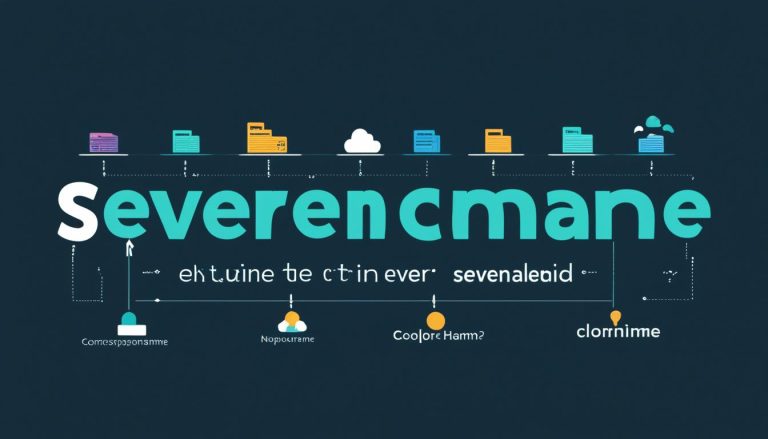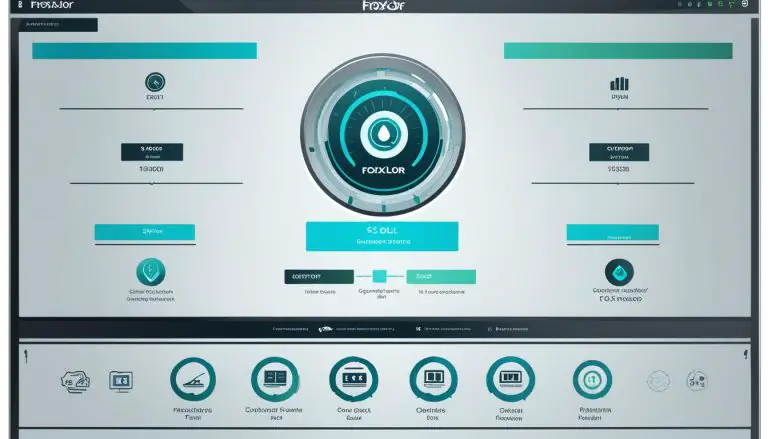Unraveling the Mystery: What is Dart in Modern Computing?
I’m excited to explore the fascinating world of Dart programming language with you. Dart is a versatile language that has gained immense popularity in modern computing applications. Whether you’re a web developer, mobile app developer, or an enterprise seeking reliable and scalable applications, Dart has something to offer.
So, what exactly is Dart? Dart is a powerful programming language that offers a range of features and syntax for building efficient and high-performing applications. It is known for its ease of use, compatibility with various platforms, and its ability to handle complex operations.
Key Takeaways:
- Dart is a versatile programming language widely used in modern computing applications.
- It is known for its ease of use, powerful features, and compatibility with various platforms.
- Dart is popular for web development, mobile app development, and enterprise applications.
- It offers features such as type inference, asynchronous programming, and strong typing.
- Dart’s hot reload feature enables quick iterations during development.
Understanding Dart Basics and Syntax
Dart is a versatile programming language that follows a C-style syntax, making it easy to read and write. It is known for its simplicity and intuitive design, which contributes to its popularity among developers. Whether you are a beginner or an experienced developer, Dart’s syntax is straightforward and accessible.
One of the advantages of Dart is its support for both object-oriented and functional programming paradigms. This flexibility allows developers to choose the programming style that best suits their needs. Dart also provides built-in support for variables, functions, classes, and interfaces, which are fundamental building blocks in any programming language.
Another noteworthy feature of Dart is its support for type inference. This means that developers don’t always have to explicitly declare the type of a variable. Dart can automatically infer the type based on the value assigned to it. However, if developers prefer static typing, they can explicitly declare the type of variables.
Key Features of Dart Syntax:
- Dart follows a C-style syntax, making it easy to read and write.
- It supports both object-oriented and functional programming paradigms.
- It provides built-in support for variables, functions, classes, and interfaces.
- Dart supports type inference, but also allows explicit type declarations.
- The syntax is straightforward and accessible to developers at all skill levels.
Exploring Dart’s Key Features
Dart, a versatile and powerful programming language, offers a wide range of features that contribute to its popularity among developers. These features enable developers to build efficient and high-performing applications for web and mobile platforms. Here, we will explore some of the key features that make Dart a preferred choice for modern computing.
Syntax and Readability
Dart follows a C-style syntax, making it easy to read and write. This syntax is intuitive and straightforward, ensuring that both beginners and experienced developers can quickly grasp the language. Dart supports both object-oriented and functional programming paradigms, providing developers with the flexibility to choose their preferred style of coding.
Fast Execution and Just-in-Time Compilation
Dart’s virtual machine allows for fast and efficient execution of code. It includes a just-in-time (JIT) compiler, which enables quick development cycles by compiling code on the fly. The JIT compiler also facilitates hot reload, a powerful feature that allows developers to see code changes in real-time without restarting the application. This feature greatly enhances productivity and speeds up the development process.
Built-in Libraries and Tools
Dart provides a rich set of built-in libraries and tools that simplify common programming tasks. These libraries cover a wide range of functionalities such as networking, file input/output, and user interface development. Additionally, Dart’s built-in support for asynchronous programming allows developers to write performant and responsive applications that can handle concurrent operations effectively.
| Key Features | Description |
|---|---|
| Virtual Machine | A virtual machine that enables fast and efficient execution of Dart code. |
| Just-in-Time Compilation | A just-in-time compiler that allows for quick development cycles and hot reload. |
| Built-in Libraries | Pre-built libraries for common tasks like networking, file I/O, and UI development. |
| Asynchronous Programming | Support for asynchronous programming to write performant and responsive applications. |
Dart vs JavaScript: A Comparison
When it comes to web development, two programming languages often come to mind: Dart and JavaScript. Both have their own strengths and weaknesses, making them suitable for different scenarios. In this section, we will compare Dart and JavaScript to help you understand their key differences and make an informed decision for your projects.
Dart
Dart is a compiled language, meaning that its code is converted into machine code before execution. This compilation process results in faster performance compared to JavaScript, which is an interpreted language. The performance boost provided by Dart’s compilation makes it an excellent choice for applications that require high efficiency, such as data processing or complex calculations.
Another significant difference between Dart and JavaScript is their type systems. Dart has a more static type system, allowing developers to catch errors early in the development process. This can lead to more reliable and bug-free code. On the other hand, JavaScript has a dynamic type system, offering more flexibility but also requiring additional caution when coding to avoid runtime errors.
JavaScript
JavaScript, being the language of the web, has a larger community and ecosystem compared to Dart. This extensive community support translates into a wide variety of libraries, frameworks, and resources readily available for JavaScript developers. If you’re looking for a language with abundant resources and an active community, JavaScript is an excellent choice.
One of the key advantages of JavaScript is its compatibility with different browsers. JavaScript is supported by all major web browsers, making it a universal language for web development. This compatibility ensures that JavaScript code can run seamlessly across different platforms and devices, providing a consistent experience to users.
Dart vs. JavaScript: A Summary
In summary, Dart and JavaScript are both powerful languages with their own unique features and advantages. Dart’s compiled nature and static type system make it ideal for performance-critical applications. On the other hand, JavaScript’s extensive community and compatibility with browsers make it a versatile language for web development.
| Dart | JavaScript | |
|---|---|---|
| Type System | Static | Dynamic |
| Performance | Faster (compiled) | Slower (interpreted) |
| Community | Smaller | Larger |
| Compatibility | Limited | Universal |
Ultimately, the choice between Dart and JavaScript depends on your project requirements and personal preferences. Consider the specific needs of your application, the desired performance, the availability of resources, and the level of community support when making your decision.
Dart for Web Development
Dart provides a robust framework called Flutter for building web applications. Flutter allows developers to create beautiful and responsive user interfaces using a single codebase that can be deployed to multiple platforms. It offers a rich set of pre-built widgets and tools for creating interactive web apps. With its hot reload feature, developers can make changes to the code and see the updates instantly, making the development process faster and more efficient. Dart’s versatility and performance optimizations make it a compelling choice for web developers.
One of the key advantages of using Dart for web development is its ability to create native-like experiences. Flutter’s widgets provide a high degree of customization and enable developers to build visually appealing and performant web apps. Additionally, Dart’s strong typing system helps catch errors early in the development process, leading to more reliable and stable code.
Table: Comparison of Dart and JavaScript for Web Development
| Dart | JavaScript | |
|---|---|---|
| Execution Speed | Faster | Slower |
| Type System | Static Typing | Dynamic Typing |
| Community | Growing | Large and Mature |
| Development Efficiency | High | Varies |
Dart’s fast execution speed and performance optimizations make it ideal for building responsive and efficient web applications. Its hot reload feature and extensive widget library provide developers with the tools to create visually appealing and interactive web apps. While JavaScript has a larger and more mature community, Dart’s growing community and strong typing system make it an attractive choice for web development.
In conclusion, Dart’s integration with Flutter and its features like hot reload and strong typing make it a powerful language for web development. With its ability to create native-like experiences and its growing community, Dart is poised to play a significant role in the future of web development.
Dart for Mobile App Development
Mobile app development has become a crucial aspect of modern computing, and Dart, along with the Flutter framework, offers a powerful solution for developers. With Dart’s versatility and Flutter’s cross-platform capabilities, developers can build native-like mobile applications for both iOS and Android using a single codebase. This not only streamlines the development process but also saves valuable time and resources.
One of the standout features of Dart for mobile app development is its hot reload functionality. This feature allows developers to make instant changes to the code and immediately see the updates on the app, significantly reducing development cycles. The ability to iterate quickly and efficiently is invaluable for creating high-quality mobile apps that meet the needs and expectations of users.
Additionally, Flutter provides a rich set of widgets and tools that enable developers to create visually appealing and performant mobile apps. These pre-built widgets offer a wide range of functionalities, making it easier to build interactive and responsive user interfaces. Whether it’s creating beautiful animations or implementing complex gestures, Flutter provides developers with the tools they need to deliver a seamless user experience.
Advantages of Dart for Mobile App Development
| Advantages | Explanation |
|---|---|
| Code Reusability | Dart allows developers to write code once and deploy it across multiple platforms, reducing development time and effort. |
| Performance Optimization | With Dart’s compiler and Flutter’s rendering engine, mobile apps built with Dart have excellent performance and responsiveness. |
| Hot Reload | The hot reload feature in Dart enables quick iterations during development, allowing developers to see code changes in real-time. |
| Rich Widget Library | Flutter provides a wide range of pre-built widgets and tools for creating visually appealing and interactive mobile app interfaces. |
Overall, Dart, in combination with Flutter, offers a robust and efficient solution for mobile app development. From code reusability to performance optimization, Dart provides developers with the tools and capabilities they need to create high-quality mobile apps. With its versatile features and cross-platform support, Dart is undoubtedly a valuable tool in the mobile app development landscape.
Dart Tutorials and Learning Resources
Interested in learning Dart? There are numerous tutorials and learning resources available to help you get started. Whether you’re a beginner or an experienced developer, these resources offer step-by-step guidance on Dart programming and provide valuable insights into its features and best practices.
Online platforms such as the official Dart website and learning platforms like Udemy and Coursera offer comprehensive Dart tutorials that cover everything from basic syntax to advanced concepts. These tutorials often include hands-on exercises and coding challenges to ensure a practical learning experience.
Video tutorials on platforms like YouTube and Pluralsight are also a great way to learn Dart. They provide visual demonstrations and explanations of key concepts, making it easier to understand and apply them in your own projects. Additionally, these video tutorials often feature real-world examples and case studies that illustrate the use of Dart in different scenarios.
Community Support and Discussion Boards
In addition to tutorials, there are vibrant community forums and discussion boards dedicated to Dart programming. These platforms serve as valuable resources where developers can ask questions, share knowledge, and seek help from experienced Dart programmers.
Platforms like Reddit, Stack Overflow, and Discord have dedicated communities and channels where developers can engage in discussions, share code snippets, and troubleshoot issues. These platforms offer a collaborative learning environment where you can interact with other developers, learn from their experiences, and stay updated with the latest trends and developments in the Dart community.
So, whether you prefer written tutorials, video courses, or community-driven discussions, there are plenty of Dart learning resources available to help you master the language and build amazing applications.

The Advantages of Using Dart
Dart is a versatile and powerful programming language that offers several advantages for developers. Whether you’re building web applications or mobile apps, Dart provides a range of features and capabilities that can enhance your development process and improve the performance of your applications.
Fast Execution Speed
One of the key advantages of using Dart is its fast execution speed. Dart includes a virtual machine that allows for efficient and optimized execution of code. This means that your applications can run smoothly and responsively, providing a seamless user experience. The just-in-time compiler in Dart also enables quick development cycles, allowing you to make changes to your code and see the updates instantly.
Code Reusability
Another advantage of Dart is its ability to reuse code across different platforms. With Dart, you can write a single codebase for both web and mobile applications, saving time and effort. This code reusability not only speeds up the development process but also ensures consistency across different platforms. By leveraging Dart’s compatibility with frameworks like Flutter, you can build native-like applications for both iOS and Android using the same codebase.
Strong Typing and Error Detection
Dart’s strong typing system helps catch errors early in the development process, making it easier to write reliable code. By enforcing strict type checks, Dart reduces the likelihood of runtime errors and improves the overall stability of your applications. This can save you time and effort by catching potential issues before they become more difficult to debug. Dart also provides tools and features for asynchronous programming, making it easier to handle complex operations and ensure smooth execution.
| Advantages of Using Dart | Description |
|---|---|
| Fast execution speed | Dart’s virtual machine enables efficient and optimized execution of code, resulting in responsive applications. |
| Code reusability | Dart’s compatibility with frameworks like Flutter allows for building applications for multiple platforms using a single codebase. |
| Strong typing and error detection | Dart’s strong typing system helps catch errors early in the development process, ensuring more reliable code. |
Dart offers several advantages for developers, including fast execution speed, code reusability, and strong typing. These advantages can significantly improve the development process and enhance the performance of your applications.
Dart for Enterprise Applications
When it comes to enterprise applications, Dart proves to be a valuable asset for businesses seeking reliability and scalability. Whether it’s developing data analytics platforms, financial systems, or customer management tools, Dart’s versatile nature allows for the creation of robust and efficient applications to meet various business needs.
One of the advantages of using Dart for enterprise applications is its strong typing system. This feature ensures more reliable code by catching errors early in the development process. With Dart’s strong typing, businesses can have confidence in the stability and accuracy of their applications, resulting in smoother operations and increased productivity.
Additionally, Dart’s performance optimizations make it well-suited for handling large datasets and complex operations. This is particularly crucial in the enterprise space, where businesses often deal with vast amounts of data. Dart’s efficiency in processing and managing data contributes to the overall performance and reliability of enterprise applications.
Furthermore, Dart integrates seamlessly with existing systems and frameworks, making it a practical choice for enterprise-level applications. The ability to leverage Dart alongside other technologies allows businesses to streamline their development processes and take advantage of the language’s capabilities without disrupting their current infrastructure.
In summary, Dart’s reliability, scalability, and integration capabilities make it a suitable language for enterprise applications. With its strong typing system and performance optimizations, businesses can build robust and efficient applications for their specific needs. Whether it’s data analytics, financial systems, or customer management tools, Dart provides the necessary tools and features to ensure the success of enterprise-level applications.
Dart in the Future of Computing
As technology continues to advance at a rapid pace, the role of programming languages in shaping the future of computing cannot be overstated. Dart, with its versatility and powerful features, is well-positioned to play a significant role in this ever-evolving landscape.
One of the key reasons why Dart is paving its way into the future is its compatibility with various platforms and frameworks, such as Flutter. As the demand for web and mobile applications continues to grow, Dart’s capabilities in these areas give it a competitive edge. With Flutter, developers can build beautiful and responsive user interfaces using a single codebase, enabling them to save time and resources while ensuring compatibility across multiple platforms.
| Dart in the Future | Advantages |
|---|---|
| 1. Versatility | Dart offers the flexibility to build applications for various purposes, making it suitable for a wide range of industries and use cases. |
| 2. Performance | Dart’s fast execution speed and performance optimization contribute to the creation of efficient and responsive applications. |
| 3. Ease of Use | The intuitive syntax and straightforward nature of Dart make it accessible to both beginners and experienced developers, ensuring a smooth learning curve. |
| 4. Code Reusability | Dart’s ability to reuse code across platforms reduces development time and effort, enabling developers to create applications more efficiently. |
Furthermore, Dart’s strong typing system ensures more reliable code by catching errors early in the development process. This enhances the overall stability and quality of applications, making them more robust and less prone to bugs.
Looking ahead, Dart’s promising future lies not only in web and mobile app development but also in the enterprise space. With its reliability, scalability, and ability to handle complex operations, Dart is gaining traction in building enterprise-level applications. Its strong performance and integration capabilities make it an attractive choice for businesses seeking to develop efficient and effective solutions.
In conclusion, Dart is poised to be a force to reckon with in the future of computing. Its versatility, performance, and ease of use make it a valuable tool for developers, while its compatibility with various platforms positions it as a strong contender in the development landscape. As technology continues to evolve, Dart’s capabilities and potential for growth ensure that it will remain relevant and continue to shape the future of computing.
Conclusion
In conclusion, Dart proves to be a versatile and powerful programming language that is widely embraced in modern computing applications. With its ease of use, robust features, and compatibility with various platforms, Dart is a go-to choice for web development, mobile app development, and enterprise applications. Its syntax is straightforward and intuitive, making it accessible to both beginners and experienced developers.
Dart offers a range of key features that contribute to its popularity among developers, such as a fast virtual machine, just-in-time compiler, and garbage collector for efficient execution and memory management. Additionally, Dart’s built-in libraries and tools streamline common tasks and enable developers to create high-quality applications.
While Dart has some differences compared to JavaScript, its advantages, including faster performance, strong typing, and code reuse across platforms, make it an appealing choice. With its promising future and growing demand for web and mobile applications, Dart is positioned to play a significant role in shaping the future of computing.
FAQ
What is Dart?
Dart is a versatile programming language that is widely used in modern computing applications. It is known for its ease of use, powerful features, and compatibility with various platforms.
What are the key features of Dart?
Dart offers a range of features including a virtual machine for fast execution, a just-in-time compiler for quick development cycles, and a garbage collector for automatic memory management. It also has built-in libraries for common tasks and supports hot reload for real-time code updates.
How does Dart differ from JavaScript?
Dart is a compiled language while JavaScript is interpreted. Dart has a more static type system and offers faster performance. However, JavaScript has a larger community and ecosystem.
Is Dart suitable for web development?
Yes, Dart is popular for web development. It offers a robust framework called Flutter that allows for the creation of beautiful and responsive user interfaces.
Can Dart be used for mobile app development?
Yes, Dart is highly regarded for mobile app development. Flutter, a framework built with Dart, enables developers to create native-like mobile apps for both iOS and Android using a single codebase.
Where can I learn Dart?
There are numerous tutorials and learning resources available online for learning Dart. Online platforms, documentation, and video tutorials provide step-by-step guidance on Dart programming.
What are the advantages of using Dart?
Dart offers fast execution speed, code reuse across platforms, and a strong typing system for more reliable code. Its hot reload feature enables quick iterations during development.
Is Dart suitable for enterprise applications?
Yes, Dart is gaining traction in the enterprise space due to its reliability and scalability. It is suitable for building robust and efficient applications for various purposes.
What is the future of Dart in computing?
Dart has a promising future in the world of computing. Its versatility, performance, and ease of use position it as a strong contender in the development landscape.
- About the Author
- Latest Posts
Claudia Rothenhorst ist Medien- und Reise-Redakteurin bei der Web-Redaktion. In ihrer Freizeit reist sie gerne und schreibt darüber unter anderem auf Reisemagazin.biz.
Weitere Artikel von Ihr erscheinen u.a. im Blog der Webagentur Awantego.






